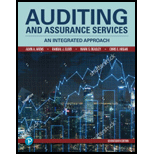
EBK AUDITING+ASSURANCE SERVICES
17th Edition
ISBN: 9780135171219
Author: ARENS
Publisher: PEARSON CO
expand_more
expand_more
format_list_bulleted
Question
Chapter 7, Problem 25.2MCQ
To determine
Identify which is considered as audit files.
Expert Solution & Answer
Want to see the full answer?
Check out a sample textbook solution
Students have asked these similar questions
Need help in this accounting questions please.
Can you help me solve this financial accounting question using the correct financial procedures?
New revenue recognition standard brings in significant changes the way a company should determine the amount of revenue to report on its financial statements. As an auditor what challenges or issues are in understanding the five step revenue recognition model as implemented by a client and how can they assess the risk of material misstatement in revenue?
Chapter 7 Solutions
EBK AUDITING+ASSURANCE SERVICES
Ch. 7 - Prob. 1RQCh. 7 - Prob. 2RQCh. 7 - Prob. 3RQCh. 7 - Prob. 4RQCh. 7 - Prob. 5RQCh. 7 - Prob. 6RQCh. 7 - Prob. 7RQCh. 7 - Prob. 8RQCh. 7 - Prob. 9RQCh. 7 - Prob. 10RQ
Ch. 7 - Prob. 11RQCh. 7 - Prob. 12RQCh. 7 - Prob. 13RQCh. 7 - Prob. 14RQCh. 7 - Prob. 15RQCh. 7 - Prob. 16RQCh. 7 - Prob. 17RQCh. 7 - Prob. 18RQCh. 7 - Prob. 19RQCh. 7 - Prob. 20RQCh. 7 - Define what is meant by a tick mark. What is its...Ch. 7 - Prob. 22RQCh. 7 - Prob. 23.1MCQCh. 7 - Prob. 23.2MCQCh. 7 - Prob. 23.3MCQCh. 7 - Prob. 24.1MCQCh. 7 - Prob. 24.2MCQCh. 7 - Prob. 24.3MCQCh. 7 - Prob. 25.1MCQCh. 7 - Prob. 25.2MCQCh. 7 - Prob. 25.3MCQCh. 7 - Prob. 26.1MCQCh. 7 - Prob. 26.2MCQCh. 7 - Prob. 26.3MCQCh. 7 - Prob. 27DQPCh. 7 - Prob. 28DQPCh. 7 - Prob. 29DQPCh. 7 - Prob. 30DQPCh. 7 - Prob. 31DQPCh. 7 - Prob. 32DQPCh. 7 - Prob. 33DQPCh. 7 - Prob. 34DQPCh. 7 - Prob. 36DQPCh. 7 - Prob. 37DQPCh. 7 - Prob. 40DQP
Knowledge Booster
Similar questions
- Indira Products has provided the following data for the month of August: a. The balance in the Finished Goods inventory account at the beginning of the month was $65,000 and at the end of the month was $29,500. b. The cost of goods manufactured for the month was $210,000. c. The actual manufacturing overhead cost incurred was $71,800 and the manufacturing overhead cost applied to Work in Process was $75,200. d. The company closes out any underapplied or overapplied manufacturing overhead to the cost of goods sold. What is the adjusted cost of goods sold that would appear on the income statement for August?arrow_forwardLand should be capitalized at what amountarrow_forwardOverhead at the end of the year was_.arrow_forward
- Ansarrow_forwardWhat is the cash conversion cycle for the firmarrow_forwardDelta Tools estimated its manufacturing overhead for the year to be $875,500. At the end of the year, actual direct labor hours were 49,600 hours, and the actual manufacturing overhead was $948,000. Manufacturing overhead for the year was overapplied by $81,400. If the predetermined overhead rate is based on direct labor hours, then the estimated direct labor hours at the beginning of the year used in the predetermined overhead rate must have been _.arrow_forward
- What is the depreciation expense for 2022arrow_forwardCan you solve this financial accounting question with the appropriate financial analysis techniques?arrow_forwardJulius provided consulting services amounting to P420, 000. His total expenses were 25%. His net income is: A. P105,000 B. P300,000 C. P315,000 D. P120,000arrow_forward
arrow_back_ios
SEE MORE QUESTIONS
arrow_forward_ios
Recommended textbooks for you
 Auditing: A Risk Based-Approach to Conducting a Q...AccountingISBN:9781305080577Author:Karla M Johnstone, Audrey A. Gramling, Larry E. RittenbergPublisher:South-Western College Pub
Auditing: A Risk Based-Approach to Conducting a Q...AccountingISBN:9781305080577Author:Karla M Johnstone, Audrey A. Gramling, Larry E. RittenbergPublisher:South-Western College Pub Auditing: A Risk Based-Approach (MindTap Course L...AccountingISBN:9781337619455Author:Karla M Johnstone, Audrey A. Gramling, Larry E. RittenbergPublisher:Cengage Learning
Auditing: A Risk Based-Approach (MindTap Course L...AccountingISBN:9781337619455Author:Karla M Johnstone, Audrey A. Gramling, Larry E. RittenbergPublisher:Cengage Learning

Auditing: A Risk Based-Approach to Conducting a Q...
Accounting
ISBN:9781305080577
Author:Karla M Johnstone, Audrey A. Gramling, Larry E. Rittenberg
Publisher:South-Western College Pub

Auditing: A Risk Based-Approach (MindTap Course L...
Accounting
ISBN:9781337619455
Author:Karla M Johnstone, Audrey A. Gramling, Larry E. Rittenberg
Publisher:Cengage Learning
